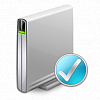How to Show Location of Recovery Image used to Reset Windows 8 or 8.1
If you're having problems with Windows 8 or 8.1 on your PC, you can try to refresh, reset, or restore it.
When you reset your PC, it will remove everything and reinstall Windows 8 or 8.1 to start over completely with a clean install.
To be able to reset Windows 8 or 8.1 you will need to first insert your Windows 8 or 8.1 installation media, UEFI installation media, or recovery drive if there is not an OEM factory recovery image present.
If you create a reset recovery image, it is used instead of your OEM recovery image, installation media, or recovery drive for a push-button reset of Windows 8 or 8.1. A reset recovery image is basically like having your installation media always connected and ready to use to reset your PC with.
This tutorial will show you how to find and see the location of the currently registered reset recovery image you created in Windows 8 or 8.1.
You must be signed in as an administrator to be able to do the steps in this tutorial.
When you reset your PC, it will remove everything and reinstall Windows 8 or 8.1 to start over completely with a clean install.
To be able to reset Windows 8 or 8.1 you will need to first insert your Windows 8 or 8.1 installation media, UEFI installation media, or recovery drive if there is not an OEM factory recovery image present.
If you create a reset recovery image, it is used instead of your OEM recovery image, installation media, or recovery drive for a push-button reset of Windows 8 or 8.1. A reset recovery image is basically like having your installation media always connected and ready to use to reset your PC with.
This tutorial will show you how to find and see the location of the currently registered reset recovery image you created in Windows 8 or 8.1.
You must be signed in as an administrator to be able to do the steps in this tutorial.
Here's How:
1. Open an elevated command prompt.
2. In the elevated command prompt, copy and paste the command below, and press Enter. (see screenshots below)
:ar: reagentc /info
3. If there is currently not a reset recovery image registered, then you will see this below to the right of Recovery image location.
4. If there is a reset recovery image registered, then you will see this below to the right of Recovery image location showing you the full path of the folder containing the install.esd or install.wim file registered as the recovery image.
To help make sense of the location path above, you can open Disk Management (diskmgmt.msc).
5. When finished, you can close the command prompt if you like.
That's it,
Shawn
Attachments
Last edited by a moderator:





